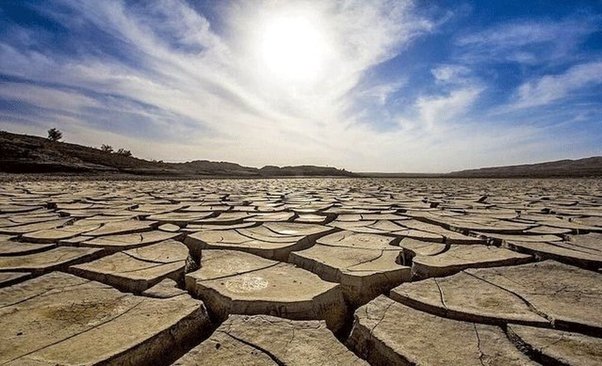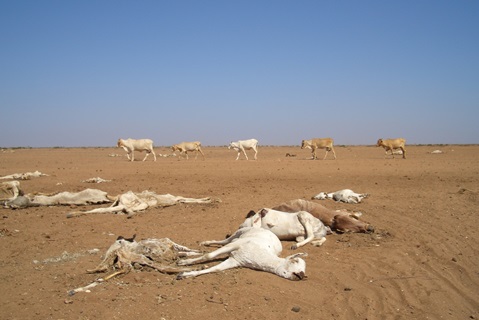Drought As Insidious Natural Disaster: A Looming Crisis in the Present World
Introduction
Drought, an insidious natural disaster, has emerged as a significant concern in the present world. It is a prolonged and abnormal deficiency of precipitation, leading to water shortages, agricultural losses, ecological imbalances, and socioeconomic upheavals. In recent years, the frequency, intensity, and duration of drought events have escalated, exacerbated by climate change, unsustainable water management practices, and burgeoning global population. This essay delves into the multifaceted dimensions of drought, its impacts on various sectors, and the imperative need for proactive measures to mitigate its adverse effects.
Understanding Drought
Drought manifests in diverse forms, including meteorological, hydrological, agricultural, and socioeconomic droughts. Meteorological drought results from prolonged periods of below-average precipitation, altering weather patterns and moisture availability. Hydrological drought pertains to deficits in surface and groundwater resources, disrupting water supply systems, and affecting aquatic ecosystems. Agricultural drought affects soil moisture levels, impeding crop growth, diminishing yields, and jeopardizing food security. Socioeconomic drought encompasses the broader ramifications of water scarcity, encompassing economic losses, social upheavals, and political tensions.
Causes of Drought
The exacerbation of droughts in the present world can be attributed to a confluence of natural and anthropogenic factors. Climate change, primarily driven by human activities such as greenhouse gas emissions, has altered precipitation patterns, leading to erratic rainfall distribution and prolonged dry spells. Deforestation, soil degradation, and land-use changes have disrupted hydrological cycles, reducing water retention capacity and exacerbating drought vulnerability. Overexploitation of water resources, inefficient irrigation practices, and unsustainable agricultural intensification have depleted groundwater reserves and exacerbated water scarcity in drought-prone regions.
Impacts of Drought
The impacts of drought reverberate across various sectors, inflicting profound socioeconomic and environmental repercussions. In agriculture, drought-induced water stress impairs crop growth, reduces yields, and jeopardizes food security, particularly in developing countries reliant on rain-fed agriculture. Livestock and pastoral communities face fodder shortages, livestock deaths, and livelihood insecurities, exacerbating poverty and rural distress. Water scarcity exacerbates conflicts over dwindling resources, exacerbating social tensions, and undermining peace and stability in affected regions.
In urban areas, water scarcity disrupts municipal water supply systems, necessitating stringent conservation measures, water rationing, and the exploration of alternative water sources. Drought-induced water shortages impede industrial activities, affecting production processes, supply chains, and economic growth. Energy production, particularly hydropower generation, is hampered by reduced water availability, leading to power shortages, energy crises, and economic losses. Ecosystems suffer from habitat degradation, biodiversity loss, and diminished ecosystem services, exacerbating ecological imbalances and undermining resilience to climate change.
Vulnerable Regions and Populations
Certain regions and populations are disproportionately vulnerable to the impacts of drought, exacerbating existing inequalities and vulnerabilities. Arid and semi-arid regions, such as sub-Saharan Africa, the Middle East, and parts of Asia, are particularly susceptible to recurrent droughts due to their fragile ecosystems, limited water resources, and high dependence on rain-fed agriculture. Smallholder farmers, rural communities, and marginalized populations bear the brunt of drought impacts, lacking access to adaptive resources, financial safety nets, and social support systems.
Women, who often play a central role in agricultural production and water management, are disproportionately affected by drought, facing increased workloads, food insecurity, and limited economic opportunities. Children are vulnerable to malnutrition, waterborne diseases, and disrupted education due to drought-induced food shortages, water scarcity, and household stress. Indigenous communities, whose livelihoods and cultural identities are intimately tied to natural resources, confront displacement, cultural erosion, and loss of traditional knowledge in the face of prolonged droughts.
Adaptation and Resilience
Building resilience to drought entails a multifaceted approach encompassing sustainable water management, climate adaptation strategies, community-based interventions, and policy reforms. Diversification of water sources, including rainwater harvesting, groundwater recharge, and wastewater reuse, enhances water security and mitigates the impacts of water scarcity during droughts. Investment in climate-smart agriculture, resilient crop varieties, and efficient irrigation technologies improves agricultural productivity and enhances the adaptive capacity of farming communities.
Integrated water resource management, encompassing watershed conservation, soil moisture retention, and ecosystem restoration, fosters water sustainability and enhances ecological resilience to drought. Early warning systems, drought monitoring tools, and risk assessment frameworks enable proactive drought preparedness, facilitating timely interventions, and reducing vulnerability to drought impacts. Strengthening social safety nets, livelihood diversification, and community-based adaptation initiatives empowers vulnerable populations, enhancing their resilience to drought-induced shocks and fostering sustainable development.
International Cooperation and Governance
Addressing the complex challenges posed by drought necessitates concerted efforts at the national, regional, and global levels, underpinned by multilateral cooperation, policy coordination, and capacity-building initiatives. International agreements such as the United Nations Framework Convention on Climate Change (UNFCCC) and the Sendai Framework for Disaster Risk Reduction provide frameworks for collective action, knowledge sharing, and resource mobilization to enhance resilience to climate-related hazards, including drought.
Transboundary water management agreements, watershed management initiatives, and regional cooperation mechanisms facilitate the equitable allocation and sustainable utilization of shared water resources, reducing the risk of water conflicts and fostering peace and cooperation among riparian states. Investments in drought preparedness, early warning systems, and climate adaptation measures bolster the resilience of vulnerable regions and communities, reducing the humanitarian and economic costs of drought disasters.
Drought poses a formidable challenge in the present world, with far-reaching implications for human well-being, environmental sustainability, and socioeconomic development. Addressing the root causes of drought, enhancing adaptive capacity, and fostering resilience are imperative to mitigate the impacts of drought and build a more sustainable and equitable future. Through concerted efforts, inclusive governance, and international cooperation, we can navigate the complexities of drought risk and forge pathways towards a more resilient and water-secure world for present and future generations.
Innovations in Technology and Research
In the quest to combat drought, advancements in technology and scientific research offer promising solutions to enhance drought resilience and improve water management practices. Remote sensing technologies, such as satellite imagery and Geographic Information Systems (GIS), facilitate the monitoring of drought conditions, mapping of water resources, and assessment of vegetation health, enabling timely decision-making and resource allocation. Climate modeling and forecasting tools provide insights into future drought trends, helping policymakers, and stakeholders anticipate and mitigate potential impacts.
Innovations in water-saving technologies, such as drip irrigation, precision agriculture, and soil moisture sensors, optimize water use efficiency, reduce water wastage, and enhance agricultural productivity in water-stressed environments. Desalination technologies offer a means of augmenting freshwater supplies in coastal regions facing water scarcity, albeit with environmental and economic considerations. Advances in rainwater harvesting, fog collection, and atmospheric water generation technologies provide decentralized solutions for water provision in arid and semi-arid regions, empowering communities to harness alternative water sources and reduce reliance on conventional water supplies.
Biotechnological innovations, including drought-resistant crop varieties, genetic engineering, and precision breeding techniques, hold promise for enhancing agricultural resilience to drought-induced water stress, pests, and diseases. Integrated agroecological approaches, such as conservation agriculture, agroforestry, and soil restoration practices, promote soil health, biodiversity, and water retention capacity, mitigating the impacts of drought and building resilience in agroecosystems. Social innovations, such as community-based water management initiatives, participatory decision-making processes, and knowledge-sharing platforms, foster local ownership and empowerment, enhancing adaptive capacity and resilience to drought at the grassroots level.
The Role of Education and Awareness
Education and awareness play a pivotal role in building resilience to drought, fostering a culture of sustainability, and empowering communities to adopt adaptive practices. Education campaigns, training programs, and outreach initiatives raise awareness about the causes and impacts of drought, imparting knowledge on water conservation, sustainable agriculture, and disaster preparedness. Environmental education in schools, universities, and communities instills values of stewardship, resourcefulness, and resilience, cultivating a sense of responsibility towards water resources and the environment.
Capacity-building initiatives, vocational training, and skills development programs equip farmers, water managers, and policymakers with the tools, techniques, and knowledge needed to mitigate drought risks, enhance water security, and promote sustainable development. Public participation, stakeholder engagement, and community-driven initiatives facilitate the co-creation of solutions, harnessing local knowledge, expertise, and resources to address the complex challenges posed by drought.
Addressing the multifaceted challenges posed by drought requires a holistic approach encompassing technological innovation, scientific research, policy reform, and community empowerment. By harnessing the power of innovation, education, and collective action, we can build resilience to drought, enhance water security, and promote sustainable development in a changing climate. As we confront the pressing realities of water scarcity and environmental degradation, concerted efforts at the local, national, and global levels are imperative to safeguard water resources, protect vulnerable communities, and forge a more resilient and sustainable future for generations to come.
The Role of Policy and Governance
Effective policy frameworks and governance structures are essential for addressing the complex challenges posed by drought and ensuring equitable access to water resources. Integrated water resource management (IWRM) approaches, grounded in principles of sustainability, equity, and participatory decision-making, provide a framework for balancing competing water demands, managing water allocation, and safeguarding ecosystem health. National drought management policies, contingency plans, and early warning systems enable proactive drought preparedness, facilitating timely interventions and reducing the vulnerability of communities to drought impacts.
Policy instruments such as water pricing mechanisms, water rights frameworks, and water use regulations incentivize efficient water use, promote conservation measures, and discourage wasteful practices. Water governance mechanisms, including stakeholder participation, multi-level coordination, and institutional collaboration, foster inclusive decision-making processes, enhance transparency, and build trust among water users, policymakers, and civil society stakeholders.
International agreements, such as the Sustainable Development Goals (SDGs) and the Paris Agreement on Climate Change, provide overarching frameworks for addressing water-related challenges, including drought, within a global context. Transboundary water cooperation agreements, river basin management initiatives, and regional dialogues promote shared governance of transboundary water resources, reducing the risk of conflict and fostering cooperation among neighboring countries.
Resilience Building at the Community Level
At the community level, resilience-building initiatives play a crucial role in enhancing adaptive capacity, fostering social cohesion, and reducing vulnerability to drought. Community-based water management committees, farmer cooperatives, and indigenous water governance systems empower local communities to actively participate in decision-making processes, manage water resources sustainably, and adapt to changing environmental conditions.
Investments in infrastructure development, such as small-scale water harvesting structures, decentralized water treatment facilities, and community-managed irrigation systems, improve access to water services and enhance resilience to drought-induced water scarcity. Diversification of livelihoods, promotion of alternative income-generating activities, and support for small-scale enterprises reduce dependency on rain-fed agriculture and enhance economic resilience to drought shocks.
Social safety nets, insurance schemes, and microfinance initiatives provide financial protection and support to vulnerable households during periods of drought-induced hardship, helping to prevent the depletion of assets, the loss of livelihoods, and the exacerbation of poverty. Knowledge exchange platforms, participatory learning networks, and peer-to-peer mentoring programs facilitate the sharing of best practices, lessons learned, and innovative solutions for drought resilience among communities facing similar challenges.
Building resilience to drought requires a comprehensive and integrated approach that addresses the root causes of vulnerability, fosters adaptive capacity, and promotes sustainable water management practices. Through effective policy frameworks, governance mechanisms, and community-driven initiatives, we can mitigate the impacts of drought, enhance water security, and promote inclusive and sustainable development.
By investing in innovation, education, and collaboration, we can navigate the complexities of drought risk and forge pathways towards a more resilient and water-secure future for all. As we confront the urgent realities of climate change and water scarcity, collective action and solidarity are essential to safeguarding water resources, protecting vulnerable communities, and building a more sustainable and equitable world for present and future generations.
Challenges and Barriers to Drought Resilience
Despite the growing recognition of the importance of drought resilience, numerous challenges and barriers persist in efforts to address this complex issue. Limited access to financial resources, technological innovations, and institutional capacities constrain the ability of governments, communities, and stakeholders to implement effective drought mitigation and adaptation measures. Inadequate data, monitoring systems, and early warning mechanisms hinder timely decision-making and response efforts, exacerbating the impacts of drought on vulnerable populations.
Fragmented governance structures, competing water demands, and conflicting interests among stakeholders pose significant obstacles to integrated water resource management and collaborative drought risk reduction initiatives. Political instability, corruption, and governance failures undermine the effectiveness of drought response measures and hinder efforts to build resilience at the national and regional levels. Socioeconomic disparities, unequal access to resources, and power imbalances exacerbate vulnerability to drought impacts, disproportionately affecting marginalized and disadvantaged communities.
Climate variability and uncertainty present challenges for long-term planning and adaptation efforts, complicating efforts to anticipate and mitigate the impacts of drought in a changing climate. Limited public awareness, knowledge gaps, and misconceptions about drought risk and water management practices hinder efforts to promote behavior change and community engagement in drought resilience-building initiatives. Inertia, resistance to change, and vested interests in maintaining the status quo impede efforts to adopt innovative solutions and transformative approaches to drought mitigation and adaptation.
Opportunities for Collaboration and Synergy
Despite these challenges, there are opportunities for collaboration and synergy among stakeholders to address the complex challenges posed by drought and enhance resilience at the local, national, and global levels. Multi-stakeholder partnerships, cross-sectoral collaboration, and inclusive decision-making processes can harness diverse perspectives, expertise, and resources to develop holistic and context-specific solutions to drought risk reduction and water management.
Investments in research and development, knowledge sharing, and capacity-building initiatives can enhance the technical and institutional capacities of governments, communities, and stakeholders to anticipate, monitor, and respond to drought events effectively. South-South cooperation, peer learning networks, and knowledge exchange platforms facilitate the sharing of best practices, lessons learned, and innovative approaches to drought resilience among countries facing similar challenges.
Empowering women, youth, and marginalized groups as agents of change and decision-makers in drought resilience-building efforts can enhance social equity, inclusion, and sustainability. Strengthening community-based institutions, participatory governance mechanisms, and indigenous knowledge systems fosters local ownership, resilience, and adaptive capacity to drought impacts.
Conclusion
In conclusion, addressing the complex challenges posed by drought requires collective action, political will, and transformative change across multiple scales and sectors. By leveraging partnerships, innovation, and collaboration, we can build resilience to drought, enhance water security, and promote sustainable development in a changing climate.
Investments in research, technology, and capacity-building initiatives are essential to enhance the adaptive capacity and resilience of communities, ecosystems, and economies to drought impacts. Strengthening governance mechanisms, promoting inclusive decision-making processes, and addressing socioeconomic inequalities can enhance the effectiveness of drought response measures and build resilience at the local, national, and global levels.
As we confront the urgent realities of climate change and water scarcity, proactive measures, and sustained commitment are imperative to safeguard water resources, protect vulnerable populations, and build a more resilient and sustainable future for present and future generations.



